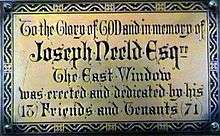Joseph Neeld
Joseph Neeld (1789–1856) was Member of Parliament of the United Kingdom for the rotten borough of Gatton, Surrey in 1830 and for Chippenham, Wiltshire, England from 1830 to 1856.[1]
Career
Neeld was one of five brothers born to Joseph Neeld (1754–1828), a solicitor[2] and Mary (née Bond) (1765–1857); the family lived in Hendon, Middlesex.[3]
He seems to have qualified as a Barrister of the Inner Temple[4] but it is known that he set out on a career in property management; in 1821 he took a lease on land in Paddington owned by Westminster Abbey.[5]
In 1828, he inherited the substantial sum of £800,000 from his famous great-uncle, Philip Rundell the silversmith, described by James Losh as a "tyrannical miser". The will stated this was a reward to Neeld for giving up a "lucrative profession" to take care of Rundell for thirteen years.[6] With this bequest, Neeld bought the Manor of Grittleton, about six miles northwest of Chippenham.[7] He spent from 8 March to 30 July 1830 as Member of Parliament for Gatton,[8] a rotten borough with six houses and one elector but returning two Members,[9] which was abolished by the Reform Act of 1832. He was then elected to represent Chippenham. He married Lady Caroline Ashley Cooper, daughter of the 6th Earl of Shaftesbury on 1 January 1831; however, the marriage did not last for long.[3] This led to a series of legal disputes which ended with Lady Caroline failing to achieve a divorce, but being granted a legal separation.[3] It had been revealed that Neeld already had a daughter by a French woman, and accordingly at his death Neeld had no legitimate heirs.[3]
From 1832, Neeld began the reconstruction of Grittleton House in Victorian Gothic revival style, and set about furnishing it with an extensive collection of antiques and paintings.[7] He was also a philanthropist, donating about £12,000 for the construction of a Town Hall for Chippenham,[10] and building houses in Grittleton for his tenants.[3] Elsewhere in Grittleton parish, at Leigh Delamere he commissioned the rebuilding of St Margaret of Antioch Church (1846)[11][12] and a row of almshouses (1848).[13]
His Parliamentary career was less successful; despite being a Member of Parliament for nearly 24 years, he spoke not once in the House of Commons.[1]
Legacy
Neeld died on 24 March 1856,[1] causing a by-election in Chippenham, and leaving no legitimate heirs; he willed his property to his brother John. His name is commemorated in the Neeld Hall in Chippenham, as well as a row of cottages in Hendon which was built in 1870.[3]

In Grittleton itself, his name lives on in the name of the village pub, the Neeld Arms, and in the east window of the church of St Mary the Virgin, accompanied by a plaque stating the window to have been "erected and dedicated by his (18) Friends and Tenants (71)". In Maida Hill, North Westminster, formerly the Borough of Paddington, there are also a Neeld Arms[14] and a Grittleton Road.
Grittleton House became Grittleton House School, which closed in 2016. Neeld's collection of art was split up, some pieces now being in the National Portrait Gallery[15] and some in the Victoria and Albert Museum.[16]
See also
References
- 1 2 3 "Mr Joseph Neeld". Hansard. Parliament of the United Kingdom. Retrieved 2009-03-09.
- ↑ "Ex Libris//Bookplates: December 2007". bookplate-jvarnoso.blogspot.com. Retrieved 2009-03-09.
- 1 2 3 4 5 6 "Notable Neelds". notableneelds.com. Archived from the original on 28 January 2011. Retrieved 2009-03-09.
- ↑ The Annual Biography and Obituary - Google Book Search. books.google.co.uk. Retrieved 2009-03-09.
- ↑ "Paddington - Manors and Other Estates". British History Online. Institute of Historical Research and the History of Parliament Trust. Retrieved 2009-03-09.
- ↑ Unknown (1828). The Annual Biography and obituary for the Year 1828. London: Longman, Rees, Orme, Brown and Green. p. 20.
- 1 2 "Grittleton House - History". www.grittletonhouse.co.uk. Archived from the original on 12 March 2009. Retrieved 2009-03-09.
- ↑ "Gatton (Surrey) 1660–1832". Hansard. Parliament of the United Kingdom. Retrieved 2009-03-09.
- ↑ "Parishes - Gatton". British History Online. Retrieved 2010-10-14.
- ↑ Historic England. "New Town Hall and Neeld Hall (1268113)". National Heritage List for England. Retrieved 21 January 2017.
- ↑ "St Margaret of Antioch, Leigh Delamere". Churches Conservation Trust. Retrieved 7 October 2010.
- ↑ "Church of St Margaret". Images of England. English Heritage. Retrieved 7 October 2010.
- ↑ Historic England. "The Almshouses (1022291)". National Heritage List for England. Retrieved 21 January 2017.
- ↑ "Planning application 15/00428/FULL". City of Westminster: Planning. March 2015. Retrieved 21 January 2017.
- ↑ "Portrait NPG 6365; Philip Rundell". National Portrait Gallery, London. Archived from the original on 31 May 2011. Retrieved 9 March 2009.
- ↑ "Maternal Affection, sculpture group in marble". Victoria and Albert Museum. Retrieved 2009-03-09.
External links
- Hansard 1803–2005: contributions in Parliament by Joseph Neeld
| Parliament of the United Kingdom | ||
|---|---|---|
| Preceded by William Scott Michael George Prendergast |
Member of Parliament for Gatton 1830 With: Michael George Prendergast |
Succeeded by John Shelley John Thomas Hope |
| Preceded by Ebenezer Fuller Maitland Frederick Gye |
Member of Parliament for Chippenham 1830–1856 With: Philip Pusey to 1831 Henry George Boldero 1831–1832 William Fox Talbot 1832–1835 Henry George Boldero from 1835 |
Succeeded by Robert Parry Nisbet Henry George Boldero |